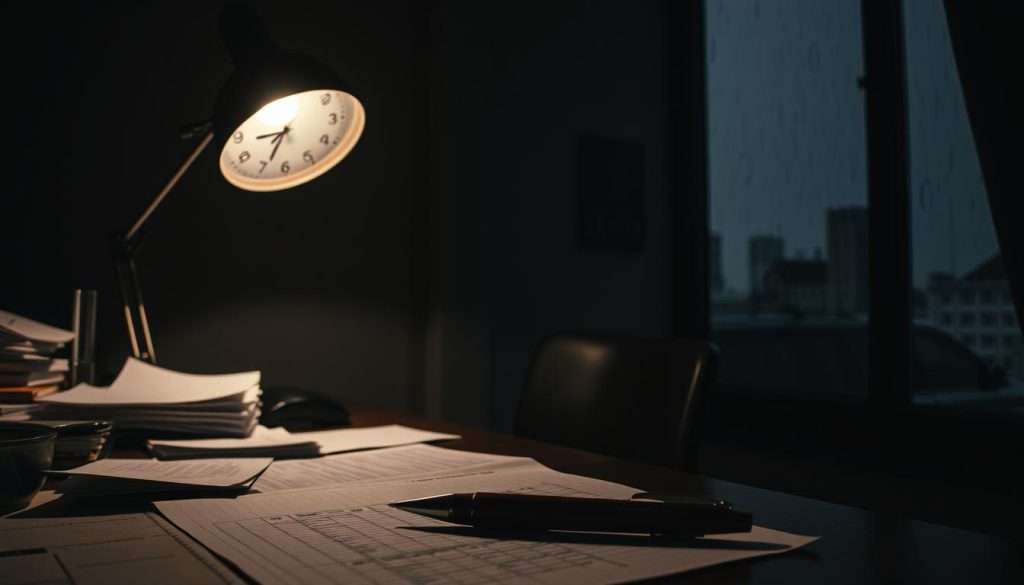Ever noticed how unfinished tasks keep popping into your mind? This is called the Zeigarnik Effect. It’s a way to boost your productivity.
Learning about the Zeigarnik Effect can help you focus better. Your brain stays on a task if it’s interrupted or not finished.
This might seem odd, but it works. Using the Zeigarnik Effect can keep you motivated. We’ll show you how to use it in your daily life to boost productivity and stay relevant.
Key Takeaways
- Understand the psychological concept of the Zeigarnik Effect
- Learn how to harness its power to boost productivity
- Discover strategies to stay motivated and driven
- Apply the Zeigarnik Effect to your daily life for improved focus
- Enhance your relevancy by leveraging this phenomenon
Understanding the Zeigarnik Effect
The Zeigarnik Effect shows how our brains deal with unfinished tasks. It’s a key concept in understanding human behavior, especially in managing tasks and remembering things.
The Psychology of Unfinished Tasks
Unfinished tasks bother us more than tasks we’ve finished. Our brains want closure, and unfinished tasks create tension. This tension helps us remember these tasks better.
Studies in cognitive psychology prove this effect is real and important. Knowing how our brains handle unfinished tasks can help us work better and remember more.
Bluma Zeigarnik’s Groundbreaking Research
In 1927, Bluma Zeigarnik, a Russian psychologist, discovered this effect. She found that interrupted tasks are remembered better than finished ones. Her work has been a big part of cognitive psychology ever since.
“The recall of interrupted tasks was found to be significantly higher than that of completed tasks, indicating a strong psychological basis for the Zeigarnik Effect.”
Zeigarnik’s research helped us understand unfinished tasks better. Using this knowledge, we can improve our memory and focus on tasks.
| Task Status | Memory Retention |
|---|---|
| Completed Tasks | Lower recall due to closure |
| Unfinished Tasks | Higher recall due to cognitive tension |
The Zeigarnik Effect and How It Works in Your Brain
Our brains are wired to respond to unfinished business, thanks to the Zeigarnik Effect. This phenomenon explains how our minds react to incomplete tasks. It creates a sense of mental tension that drives us to complete them.
Cognitive Tension and Memory Enhancement
When we start a task but don’t finish it, our brain creates cognitive tension. This tension is like a mental itch that we feel compelled to scratch. The Zeigarnik Effect shows that this tension enhances our memory by making us more aware of the unfinished task. Here are a few ways this works:
- Unfinished tasks are more memorable than completed ones.
- Cognitive tension keeps the task at the top of our mental agenda.
- Our brains are more likely to revisit and recall unfinished tasks.
Why Our Brains Fixate on Incomplete Tasks
So, why do our brains fixate on incomplete tasks? It’s because our minds are designed to seek closure. When a task is left unfinished, it creates a sense of mental discomfort. To alleviate this discomfort, our brains keep reminding us of the task until we complete it.
This can be both helpful and challenging. On one hand, it helps us stay focused on important tasks. On the other hand, it can lead to mental fatigue if we have too many open loops.
By understanding how the Zeigarnik Effect works, we can harness its power to improve our productivity and memory. Whether you’re studying for an exam or working on a project, leveraging the Zeigarnik Effect can help you stay on track and achieve your goals.
Benefits of Leveraging Mental Tension for Focus
Using mental tension can greatly improve your focus and productivity. The Zeigarnik Effect shows our brains are drawn to unfinished tasks. This makes mental tension a great tool for reaching your goals.
Improved Memory Retention
Improved memory retention is a big advantage of using mental tension. When you’re working, the Zeigarnik Effect makes your brain hold onto information better. This means you’re more likely to remember key details and recall them when needed.
Bluma Zeigarnik’s research found that unfinished tasks stay in our minds. This makes them a strong tool for learning and remembering.
Enhanced Motivation and Task Engagement
Mental tension also boosts motivation and task engagement. Leaving a task unfinished creates a “open loop” in your brain. This natural urge to finish what you started can motivate you to stay focused.
Remember, “Well begun is half done.” Using this effect can increase your motivation and help you make progress on tasks.
“The mind is not a vessel to be filled, but a fire to be kindled.” This quote shows the importance of sparking motivation and engagement. The Zeigarnik Effect can help you achieve this.
Step-by-Step Guide to Applying the Zeigarnik Effect
Let’s get practical! Here’s a step-by-step guide on how to apply the Zeigarnik Effect to your daily tasks.
Creating Strategic Interruptions
To use the Zeigarnik Effect, you need to make smart breaks in your work. Break tasks into smaller parts and take breaks at key moments.
The Perfect Timing for Breaks
Stop working when you’ve made good progress but not finished. This unfinished feeling helps you get back into it easily.
- Use the Pomodoro Technique: Work for 25 minutes, then take a 5-minute break.
- Stop at a natural pause, like finishing a section or a tough part.
- Set a specific time to stop, like the end of the day or a scheduled break.

Setting Up Cliffhangers in Your Work
Another way to use the Zeigarnik Effect is by creating cliffhangers in your work. This means leaving tasks or projects in a way that makes you want to return to them.
Techniques for Leaving Tasks Unfinished Intentionally
- End your work session with a question or problem to solve.
- Leave a task partially done, with a clear plan for next steps.
- Create a to-do list for the next day or session, highlighting key tasks.
Benefits of Cliffhangers
| Technique | Benefit |
|---|---|
| Ending with a question | Encourages curiosity and engagement |
| Leaving tasks partially completed | Provides a clear starting point for the next session |
| Creating a to-do list | Helps prioritize tasks and plan for the next session |
By using these strategies, you can tap into the Zeigarnik Effect. This will boost your productivity and focus.
Boosting Study Efficiency with Psychological Principles
As students, we’re always searching for the best study methods. Mixing the Zeigarnik Effect with other psychological ideas can really help. By knowing how our brains work, we can better remember things and stay motivated.
The Pomodoro Technique and Zeigarnik Effect
The Pomodoro Technique is about working in focused 25-minute blocks. Pairing it with the Zeigarnik Effect can make studying more efficient. By leaving tasks unfinished, you keep your brain active and eager to return to them.
For example, start a study session with a goal. Then, take a break before finishing it. This leaves your brain with a “cliffhanger” that makes you want to come back.
Creating Study Loops That Stick in Memory
To make study loops memorable, try spaced repetition. This means reviewing material at longer intervals to lock it into your memory. Mixing spaced repetition with the Zeigarnik Effect creates a powerful study method.
Bluma Zeigarnik would likely say, “The secret to learning well is knowing how our brains handle unfinished tasks.”
For instance, when studying for a history exam, start with a broad overview. Then, get into the details, and review at longer intervals. This method uses the Zeigarnik Effect to keep you focused and motivated. It also uses spaced repetition to help you remember better.
Workplace Implementation Strategies
To boost focus and efficiency, let’s explore how to apply the Zeigarnik Effect in your work environment. By understanding and leveraging mental tension, you can significantly improve task completion rates and overall productivity.
Task Management Systems That Leverage Mental Tension
One effective way to utilize the Zeigarnik Effect is by implementing task management systems that create and maintain mental tension. This can be achieved by:
- Breaking down large projects into smaller, manageable tasks
- Creating a “to-don’t” list to avoid procrastination by making tasks feel unfinished
- Using a “stop doing” list to interrupt tasks and create a sense of incompleteness
As Bluma Zeigarnik herself noted, “The more complex the task, the more it tends to occupy the person’s mind.” By leveraging this phenomenon, you can keep important tasks top of mind.

Meeting and Project Planning Techniques
Meetings and project planning are crucial aspects of workplace productivity. To apply the Zeigarnik Effect here, consider the following strategies:
- End meetings on a cliffhanger by outlining the next steps and tasks to be completed before the next meeting.
- Use project planning tools that allow you to break tasks into smaller chunks and track progress.
- Create a “parking lot” for ideas and tasks that are not immediately actionable, keeping them in mind for future reference.
By incorporating these techniques, you can harness the power of mental tension to drive your team towards completing tasks and achieving project goals. As the saying goes, “
The secret to getting ahead is to get started.
” Let’s get started on making the Zeigarnik Effect work for you!
Overcoming Procrastination Through Strategic Incompletion
Procrastination is a big problem, but what if leaving tasks undone could help? The Zeigarnik Effect shows our brains remember and go back to unfinished tasks. This makes it a great way to boost motivation and get more done.
The “Just Start” Method
The “Just Start” method is easy but effective. Starting a task, even if you won’t finish it right away, grabs your attention. It works because our brains like to work on tasks that are already started. To use it, pick a task you’ve been putting off and work on it for a few minutes. Often, starting is the hardest part, and you’ll keep going.
Using Mental Hooks to Pull You Back to Tasks
Mental hooks are like reminders that tell you to go back to unfinished tasks. By using them, you can make the most of the Zeigarnik Effect. You can leave tasks in a state of “strategic incompletion” to keep your brain engaged. For example, stop working on a project when you really want to keep going. This way, your brain will remember to come back to it.
You can also use notes or reminders as mental hooks. These leave a trail that leads you back to where you left off. This helps you stay on track and avoid procrastination.
Avoiding Cognitive Overload and Stress
Getting the most from the Zeigarnik Effect means finding a balance. It’s about using mental tension to stay focused but not too much. Too many unfinished tasks can make us tired and less productive.
When Too Many Open Loops Become Problematic
Too many tasks can cause a lot of stress and make our brains feel overwhelmed. This happens when we’re trying to do too many things at once. Our brains want to finish what we start, as Dr. Bluma Zeigarnik’s research found.
Here’s a table to show the difference between a few and many tasks:
| Aspect | Few Open Loops | Many Open Loops |
|---|---|---|
| Mental State | Focused, calm | Overwhelmed, stressed |
| Productivity | High, with good task management | Low, with constant task switching |
| Memory | Better retention of task details | Poor retention due to information overload |
Healthy Closure Practices for Mental Well-being
To stay clear of too much mental stress, we need to close tasks properly. Here are some ways to do that:
- Prioritize tasks and start with the most important ones
- Split big tasks into smaller, easier ones
- Use a system to keep track of what needs to be done
- Check and close tasks that are no longer needed
As productivity expert David Allen said, “Your mind is for having ideas, not holding them.” By using these tips, we can use the Zeigarnik Effect without getting too stressed.
Being aware of our mental load and closing tasks well helps us work better and feel less stressed. It’s about using the Zeigarnik Effect wisely and not getting too overwhelmed.
Conclusion: Transforming Your Productivity Through Psychological Insights
We’ve looked into how the Zeigarnik Effect can help you focus better and work more efficiently. It shows how our brains work when we have unfinished tasks. This can help us stay motivated to finish what we start.
Using the Zeigarnik Effect means creating interruptions and setting up cliffhangers in your work. It also means using mental hooks to keep you on track. By doing these things, you can beat procrastination and reach your goals.
It’s important to find a balance. You want to use the Zeigarnik Effect without getting too stressed. Pay attention to your mental health and use healthy ways to close tasks. This way, you can get the most out of this powerful tool.
Now, it’s your turn to try these ideas. Look for ways to use the Zeigarnik Effect in your life. With regular practice, you’ll see your productivity soar and your goals within reach!

